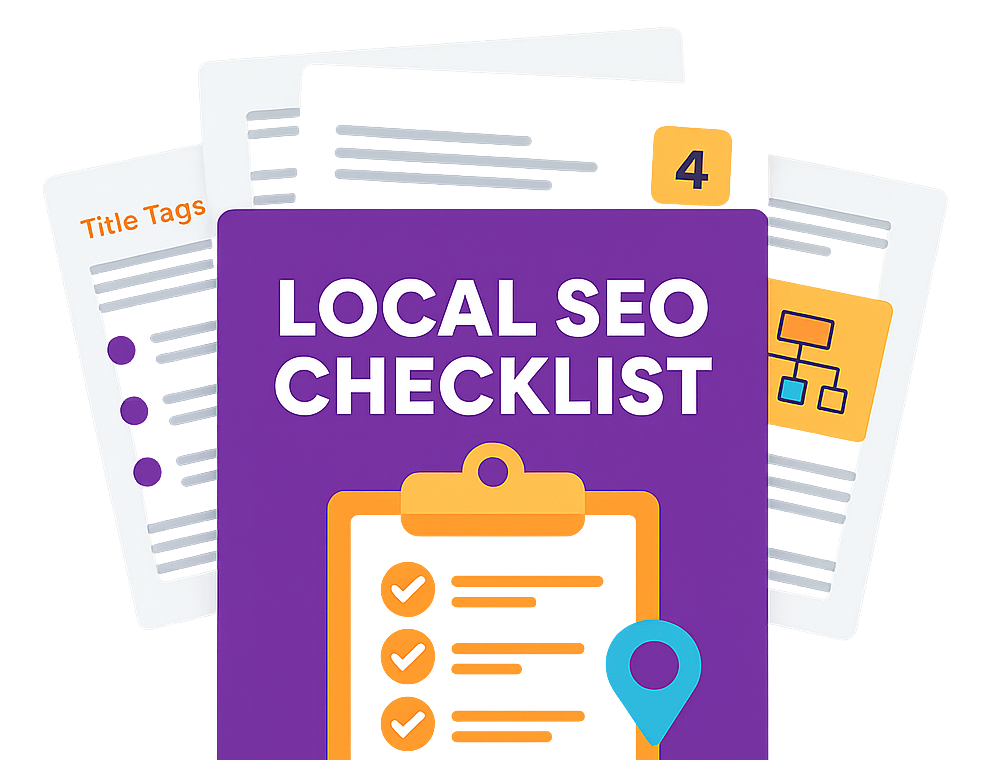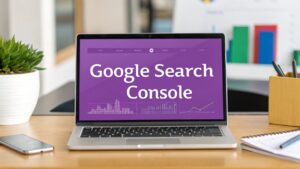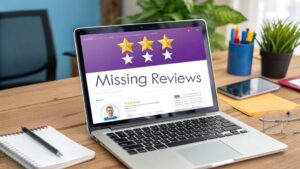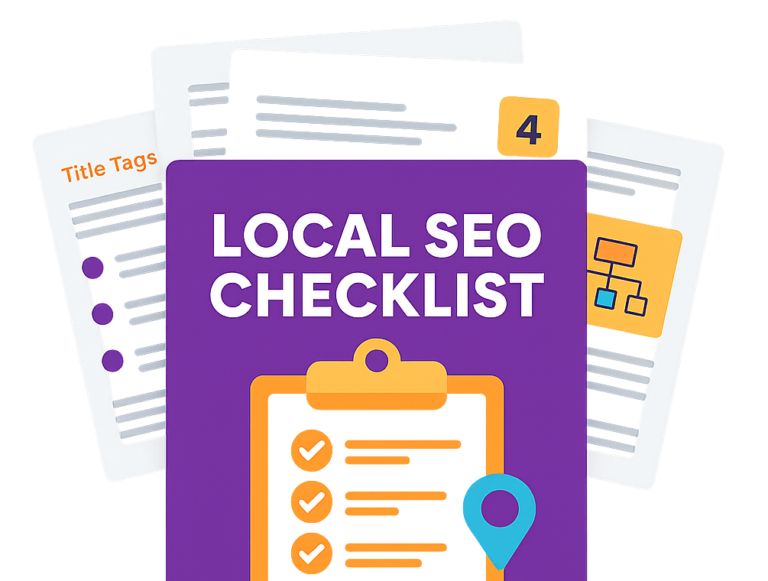Think of a local SEO audit as a complete health check for your business’s digital front door. It’s a deep dive designed to figure out exactly why local customers aren’t finding you online. The process involves systematically picking apart your Google Business Profile, your website, and your online directory listings to spot opportunities and fix the hidden problems holding back your local search rankings.
Why a Local SEO Audit is Non-Negotiable
For any business that relies on a local customer base—whether you’re a café in Bristol or a solicitor in Manchester—showing up in those "near me" searches is everything. A local SEO audit takes the guesswork out of the equation and gives you a clear roadmap to connect with these customers.
It’s the real difference between hoping people find you and making sure they do. Without a structured audit, you're almost certainly leaving money on the table and letting competitors snatch up the top spots in local search results.
This isn't about ticking off a few boxes. It's a strategic investigation into your digital footprint, uncovering the foundational issues that could be stopping your growth cold.
The Core Pillars of a Local Audit
A proper audit zeroes in on a few key areas that tell Google how relevant and authoritative your business is for a specific location. Let’s break down the main components.
To give you a quick glance, here are the core areas we’ll be investigating and why they matter to your bottom line.
Core Components of a Local SEO Audit
| Audit Component | Primary Focus | Key Business Impact |
|---|---|---|
| Google Business Profile (GBP) | Completeness, accuracy, and active management of your most critical local listing. | Drives direct engagement, phone calls, and foot traffic from Google Search and Maps. |
| Citation Consistency | Uniformity of your business Name, Address, and Phone number (NAP) across all online directories. | Builds trust with search engines and prevents customer confusion, strengthening local authority. |
| On-Page Local Signals | Website content and technical elements that clearly communicate your service areas to Google. | Improves rankings for location-specific keywords and connects your site to your physical presence. |
| Local Competitor Analysis | Analysing what top-ranking local competitors are doing right and identifying their weaknesses. | Uncovers actionable strategies to outperform rivals and capture a larger market share. |
Each of these pillars works together to build a powerful local presence that Google can't ignore.
The data backs this up. A massive 46% of all Google searches have local intent. If you’re not optimised for local, you’re invisible to nearly half of your potential customers. For small businesses trying to get a foothold, understanding how to build a strong online presence for small businesses, including local SEO, is a fundamental first step.
A complete Google Business Profile is a game-changer. Businesses that fill out their profiles thoroughly are 70% more likely to attract visits to their physical locations, turning online searches into real-world customers.
And the competition is already on it. With 64% of UK small businesses actively working on their local SEO presence, simply having a profile isn't enough anymore. A detailed audit ensures you're not just showing up but actively competing for those valuable local customers. If you want to dig deeper, these UK-focused local SEO statistics and trends really paint a clear picture of the market.
Ultimately, an audit gives you the blueprint you need for sustainable, local growth.
Auditing Your Google Business Profile
Think of your Google Business Profile (GBP) as your digital shopfront. It’s often the very first impression a potential customer has of you, so it’s easily your most important local SEO asset. A thorough audit here is the bedrock of any local SEO campaign, making sure every part of your profile is working to pull in and convert customers.
First things first, let's get the fundamentals right. Is your business name, address, and phone number (NAP) 100% accurate and identical to what's on your website? It sounds simple, but even a tiny slip-up—like using "Ltd" on your GBP but "Limited" on your site—can confuse search engines and water down your local authority.
Next up, your business categories. The primary category you choose packs the biggest punch for your local rankings. If you're a plumber in Manchester, your primary category must be "Plumber," not something vague like "Home Services." This is how you show up for the most relevant searches. You can then use secondary categories to flesh out your services, like "Boiler repair service" or "Drain cleaning service."
This visual guide breaks down the key areas to check when you're digging into your profile's performance and making sure it's complete.

As you can see, a proper audit covers everything from the core business info right through to customer engagement signals like reviews and photos.
Optimising Profile Content and Engagement
With the core details nailed down, it’s time to focus on content and how you interact with customers. High-quality photos are non-negotiable. You need a good mix: shots of your building's exterior, pictures of the inside, photos of your team, and images of your products or services in action. A profile with plenty of images feels active and cared for, which builds trust instantly.
Your business description is another area where you can make a real impact. Pack it with keywords that describe what you do and where you do it. For example, a boutique in Bristol could weave in terms like "independent fashion," "handmade jewellery," and "Bristol shopping district" to hook relevant local searches. This isn't just for appearances; businesses with keyword-rich descriptions can see a 31% improvement in visibility within Google's local pack. You can learn more about how to do this in our complete guide on Google Business Profile optimisation.
Pro Tip: The Q&A section is one of the most overlooked features on a GBP. Get ahead of the game by adding common questions and answering them yourself. Think about things like parking, accessibility, or specific services. It's a simple way to improve the user experience.
Leveraging Posts and Reviews
Google Posts are your direct line to customers in the search results. Use them to share updates, special offers, and news. Posting regularly sends a strong signal to Google that your business is active and engaged. Your reviews are just as important—they're a massive ranking factor.
A solid review strategy involves a few key actions:
- Actively asking happy customers to leave you feedback.
- Responding quickly and professionally to every review, good or bad.
- Keeping an eye on review velocity to maintain a steady flow of new feedback.
It's no secret that profiles with lots of high-rated reviews are far more likely to rank well. In fact, UK businesses that link their website to their GBP see a 23% increase in organic website traffic, making it a clear win for getting more eyes on your site.
Tidying Up Your Local Citations and Links
Beyond your Google Business Profile, your digital footprint is scattered across a huge network of online directories, apps, and websites. If your business information is inconsistent across these platforms, it acts as a massive red flag for Google. This confusion can seriously harm your local search rankings, so a citation audit is your chance to get everything in order.
Think of it like this: every time your business’s Name, Address, and Phone number (NAP) shows up online, it’s a "citation." Google relies on these to confirm your business is legitimate and located exactly where you claim it is. When details like 'St' versus 'Street' or an old phone number don't match up, it slowly chips away at that trust.

Hunting Down Inconsistent Citations
Your first job is to track down every single incorrect NAP entry out there. This means checking both structured and unstructured citations.
-
Structured Citations: These are the neat, organised listings you’ll find on major UK directories like Yell, Thomson Local, or Yelp. They have specific fields for your business name, address, and phone number, making them straightforward to check.
-
Unstructured Citations: These are more casual mentions, like a feature in a local blog post or a shout-out on a community forum. While less formal, they still add to your overall local authority.
Start by searching for your business name with any known variations and old addresses. You’ll almost certainly find duplicate listings or outdated profiles you forgot even existed. The goal here is to build a master list of all incorrect citations that need updating or removing. Following a structured process, like the one in this comprehensive local SEO checklist, will help keep you organised.
The key to a successful citation audit is ruthless consistency. Every single listing, from a major directory to a tiny local blog, must display the exact same NAP information as your Google Business Profile and your website. Even small variations can undermine your hard work.
Auditing Your Local Backlink Profile
Fixing errors is only half the battle; building authority is the other. Your backlink profile—the collection of links pointing to your website from other sites—is a powerful signal of trust to search engines. For local SEO, links from other local businesses or organisations are pure gold.
A backlink audit is all about analysing where your current links are coming from. Are they from relevant, local sources? A link from the Cambridgeshire Chamber of Commerce website is far more valuable for a Cambridge business than a random link from a blog in another country. It’s all about context.
Look for opportunities to earn links from places like:
- Local business partners or suppliers you work with
- Community charities you support or sponsor
- Local news websites or bloggers who cover your industry
- Neighbourhood associations or event organisers
These local links prove to Google that you are a genuine, trusted part of the community. This directly boosts your credibility and helps you rank higher for those all-important local searches. It’s about showing you have real roots in the area.
Strengthening Your On-Page Local Signals
Once you've sorted out your off-site presence, it’s time to turn the audit inward and look at your own website. Strong on-page local signals are absolutely vital for convincing both people and search engines that you're a legitimate local authority. This part of your local SEO audit is all about weaving location-specific details right into the fabric of your site.
The first and most fundamental check is your Name, Address, and Phone number (NAP). This information must be identical to what’s on your Google Business Profile, and it should be easy to spot on every single page—usually in the footer. Think of it as constant reinforcement, helping search engines connect your digital footprint with your physical one.
Optimising Core On-Page Elements
Next up, let's dive into your most important on-page elements. Title tags and meta descriptions are your first impression in the search results, so make them count. You need to ensure they're optimised with both your primary service and your location.
A title like "Artisan Bakery in Leeds | Fresh Sourdough & Pastries" is going to work a lot harder for you than a generic "Home | The Corner Bakery."
Here are a few other key things to check during your on-page audit:
- Location-Specific Keywords: Have you naturally mentioned your town, city, or even specific neighbourhoods in your page headers (H1s, H2s) and body copy?
- Embedded Google Map: Is there an embedded Google Map on your contact or location page? This is a direct, powerful signal to Google confirming your physical address.
- Localised Content: Don't just list your services. Create content that actually connects with your community. This could be anything from blog posts about local events you’re sponsoring to dedicated pages for each neighbourhood you serve. Our guide to the top 10 local SEO strategies has plenty of ideas on this front.
Implementing Local Business Schema
One of the most powerful, and frankly, most overlooked on-page signals is Schema markup. It's a bit of code you add to your website that speaks search engines' language, explicitly telling them what your business is, where you are, and what you do.
The screenshot below gives you a basic idea of how Schema.org structures data for a local business, clearly defining things like its name, address, and phone number.

Putting this structured data in place removes any guesswork for search engines. It’s what allows them to pull rich information like your opening hours or review ratings and display them right in the search results.
By adding Local Business Schema, you’re not just hoping Google figures out who you are; you’re handing it a perfectly organised business card. This simple technical step can significantly improve how you appear in local searches, giving you a distinct advantage. Your audit should verify this markup is present and correctly configured.
Analysing Your Local Competitors
You don't operate in a vacuum. A proper local SEO audit means knowing exactly what your competitors are doing right—and where they're dropping the ball. Understanding their strategy gives you a clear blueprint to outperform them in the Google Local Pack and snap up the customers they might be missing.
First things first, you need to identify who you're genuinely up against. These are the businesses that consistently pop up in the top three map results for your most important local search terms. Don't just guess. Run a few searches for your key services and jot down the names that keep showing up.
Once you have your list, it's time to put their digital presence under the microscope. This isn’t about copying their every move, but about finding strategic openings. A methodical approach is key here, covering several crucial areas.
Dissecting Their Google Business Profile
Your competitors' Google Business Profiles (GBPs) are a goldmine of information. A detailed look can pretty much reveal their entire local strategy.
Kick off your analysis with these checks:
- Business Categories: What primary and secondary categories are they using? This tells you exactly which services they're prioritising in their SEO.
- Photos and Videos: Take a look at the quality and quantity of their visuals. Poor-quality, outdated, or sparse photos are a huge opportunity for you to make a much better first impression.
- Review Management: How quickly and professionally are they responding to reviews? A slow or non-existent response strategy is a weakness you can exploit with excellent customer engagement.
For businesses in hyper-competitive fields, like legal services, this level of detail isn't just nice to have—it's essential. Our guide on local SEO for law firms dives deeper into how to apply these principles in a specific industry.
This focus on reviews is vital. In the UK, 42% of consumers regularly check online reviews when researching a local business, and a staggering 81% rely on Google for this information. With nearly 37% of consumers expecting a minimum four-star rating, a strong review profile is non-negotiable for success.
Uncovering Their Digital Footprint
Beyond their GBP, you need to dig into their broader online presence. As part of analysing your local competitors, a comprehensive keyword gap analysis can highlight some massive opportunities to outrank them for relevant local searches. Check their website for dedicated location or service-area pages. If they lack detailed, locally-focused content, that’s your chance to create superior pages that truly connect with your community.
Finally, investigate their local citation and backlink profiles. Are they listed in niche local directories where you aren't? Are they getting links from local charities or event sponsorships? Uncovering these patterns helps you build a more authoritative local presence and, ultimately, claim those top spots for yourself.
Your Local SEO Audit Questions Answered
Even with the best plan, you’re bound to hit a few snags or have questions pop up during a local SEO audit. To help you push through with confidence, I’ve pulled together answers to some of the most common queries I hear from business owners. This should help you turn your audit findings into genuine, tangible ranking improvements.
How Often Should I Perform a Local SEO Audit?
A full, deep-dive audit is something you should tackle every 6 to 12 months. This timeframe is long enough to give you a solid benchmark of your performance and uncover any significant issues that have cropped up.
But you don't want to leave it that long between check-ups. A "mini-audit" should be on your to-do list every quarter. Think of it as a quick health check: review your Google Business Profile for accuracy, keep an eye on new customer reviews, and scan for any new, glaring NAP inconsistencies.
Crucially, if you move your business, change your phone number, or go through a rebrand, you need to conduct a full audit immediately. Failing to do so can create massive confusion for both your customers and the search engines, potentially undoing months of hard work.
What Are the Biggest Mistakes to Avoid?
The most common mistake I see is tunnel vision on the Google Business Profile. Yes, it’s absolutely vital, but a proper local SEO audit looks at the whole picture—your website, citations, and competitors included. Neglecting the other pillars means you’re working with incomplete information.
Another major pitfall is brushing off small NAP (Name, Address, Phone number) inconsistencies. It’s easy to dismiss minor variations like 'Ltd' vs 'Limited' or 'St' vs 'Street' across different directories, but these tiny discrepancies can seriously erode your local authority in Google's eyes. They see inconsistency as a red flag.
Finally, failing to analyse what your direct local competitors are doing is a huge missed opportunity. You have to see what the top-ranking businesses in your patch are doing right. It’s the only way to understand the competitive landscape and spot where you can gain an advantage.
I’ve Done My Audit. What Should I Fix First?
Priority is everything after an audit. If you want to get the biggest impact quickly, you need to tackle your fixes in a logical order. I always recommend this approach:
- Your Google Business Profile First: Start here. Correct any errors or fill in the blanks on your GBP. It's your most visible local asset and often the very first interaction a potential customer has with your business online.
- Critical NAP Inconsistencies Next: Once GBP is sorted, move on to correcting the major NAP errors you found on key UK citation sites like Yell, Yelp, or Thomson Local. Consistency across these authoritative platforms is a massive trust signal for Google.
- Address Major On-Page Issues: Finally, turn your attention to the most significant on-page SEO problems on your website, particularly your homepage or location pages. This usually means adding your town or city to the title tag and making sure your full, correct NAP is clearly visible.
Are There Any Free Tools for a Basic Local SEO Audit?
Absolutely. You can get a lot done without spending a penny. Several free tools provide a great starting point for spotting the most urgent issues.
For a start, just use Google Search and Maps in an incognito window. This lets you see how your business appears to potential customers from a neutral perspective. Your Google Business Profile dashboard is also an essential, free audit tool in its own right.
For checking citations, a service like Moz's Check Listing offers a free scan of your NAP consistency on key directories. And to check your website's performance on mobile devices, you can’t go wrong with Google's free Mobile-Friendly Test.
A thorough local SEO audit gives you the clear, data-driven roadmap your business needs to start dominating local search results. If you're ready to uncover hidden opportunities and fix the issues holding you back, Bare Digital can help. We offer a free, no-obligation SEO Health Check to get you started.








